
GOLEM
Graph Optimiser for Learning and Evolution of Models
Stars: 53
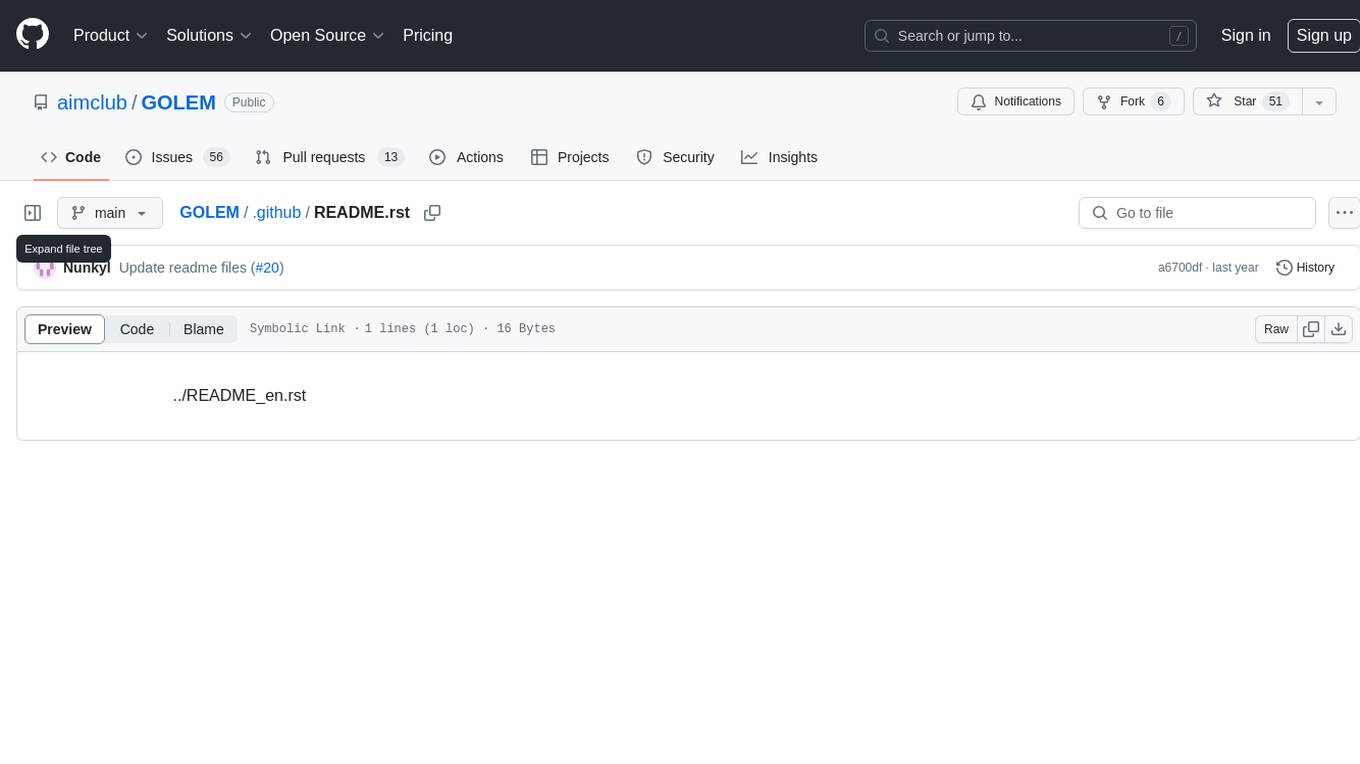
GOLEM is an open-source AI framework focused on optimization and learning of structured graph-based models using meta-heuristic methods. It emphasizes the potential of meta-heuristics in complex problem spaces where gradient-based methods are not suitable, and the importance of structured models in various problem domains. The framework offers features like structured model optimization, metaheuristic methods, multi-objective optimization, constrained optimization, extensibility, interpretability, and reproducibility. It can be applied to optimization problems represented as directed graphs with defined fitness functions. GOLEM has applications in areas like AutoML, Bayesian network structure search, differential equation discovery, geometric design, and neural architecture search. The project structure includes packages for core functionalities, adapters, graph representation, optimizers, genetic algorithms, utilities, serialization, visualization, examples, and testing. Contributions are welcome, and the project is supported by ITMO University's Research Center Strong Artificial Intelligence in Industry.
README:
.. image:: /docs/source/img/golem_logo-02.png :alt: Logo of GOLEM framework :align: center :width: 500
.. class:: center
|sai| |itmo|
|python| |pypi| |build| |integration| |coverage| |docs| |license| |tg| |rus| |mirror|
GOLEM is an open-source AI framework for optimization and learning of structured graph-based models with meta-heuristic methods. It is centered around 2 ideas:
- The potential of meta-heuristic methods in complex problem spaces.
The focus on meta-heuristics allows approaching the kinds of problems where gradient-based learning methods (notably, neural networks) can't be easily applied, like optimization problems with multiple conflicting objectives or having a combinatorial nature.
- The importance of structured models in multiple problem domains.
Graph-based learning enables solutions in the form of structured and hybrid probabilistic models, not to mention that a wide range of domain-specific problems have a natural formulation in the form of graphs.
Together this constitutes an approach to AI that potentially leads to structured, intuitive, interpretable methods and solutions for a wide range of tasks.
- Structured models with joint optimization of graph structure and properties (node attributes).
- Metaheuristic methods (mainly evolutionary) applicable to any task with a well-defined objective.
- Multi-objective optimization that can take into account both quality and complexity.
- Constrained optimization with support for arbitrary domain-specific constraints.
- Extensible to new domains.
- Interpretable thanks to meta-heuristics, structured models, and visualisation tools.
- Reproducible thanks to rich optimization history and model serialization.
GOLEM is potentially applicable to any optimization problem structures:
- that can be represented as directed graphs;
- that have some clearly defined fitness function on them.
Graph models can represent fixed structures (e.g. physical models such as truss structures) or functional models that define a data-flow or inference process (e.g. bayesian networks that can be fitted and queried).
Examples of GOLEM applications:
- Automatic Machine Learning (AutoML) with optimal ML pipelines search in
FEDOT framework <https://github.com/aimclub/FEDOT>_ - Bayesian network structure search in
BAMT framework <https://github.com/aimclub/BAMT>_ - Differential equation discovery for physical models in
EPDE framework <https://github.com/ITMO-NSS-team/EPDE>_ - Geometric design of physical objects in
GEFEST framework <https://github.com/aimclub/GEFEST>_ -
Neural architecture search <https://github.com/ITMO-NSS-team/nas-fedot>_
As GOLEM is a general-purpose framework, it's easy to imagine potential applications, for example, finite state automata search for robotics control or molecular graph learning for drug discovery, and more.
GOLEM can be installed with pip:
.. code-block::
$ pip install thegolem
Following example demonstrates graph search using reference graph & edit distance metric. Optimizer is set up with a minimal set of parameters and simple single-point mutations. For more details see examples simple_run.py <https://github.com/aimclub/GOLEM/blob/main/examples/synthetic_graph_evolution/simple_run.py>, graph_search.py <https://github.com/aimclub/GOLEM/blob/main/examples/synthetic_graph_evolution/graph_search.py> and tree_search.py <https://github.com/aimclub/GOLEM/blob/main/examples/synthetic_graph_evolution/tree_search.py>_ in directory examples/synthetic_graph_evolution <https://github.com/aimclub/GOLEM/tree/main/examples/synthetic_graph_evolution>_.
.. code-block:: python
def run_graph_search(size=16, timeout=8):
# Generate target graph sought by optimizer using edit distance objective
node_types = ('a', 'b') # Available node types that can appear in graphs
target_graph = generate_labeled_graph('tree', size, node_types)
objective = Objective(partial(tree_edit_dist, target_graph))
initial_population = [generate_labeled_graph('tree', 5, node_types) for _ in range(10)]
# Setup optimization parameters
requirements = GraphRequirements(timeout=timedelta(minutes=timeout))
gen_params = GraphGenerationParams(adapter=BaseNetworkxAdapter(), available_node_types=node_types)
algo_params = GPAlgorithmParameters(pop_size=30)
# Build and run the optimizer
optimiser = EvoGraphOptimizer(objective, initial_population, requirements, gen_params, algo_params)
found_graphs = optimiser.optimise(objective)
# Visualize results
found_graph = gen_params.adapter.restore(found_graphs[0]) # Transform back to NetworkX graph
draw_graphs_subplots(target_graph, found_graph, titles=['Target Graph', 'Found Graph'])
optimiser.history.show.fitness_line()
return found_graph
Tracing the lineage of the found_graph reveals how genetic operators (mutations, crossovers, etc.) are applied to a random graph one after another, eventually leading to the target graph:
.. image:: /docs/source/img/evolution_process.gif :alt: Evolution process :align: center
One can also notice that despite the fact that the edit distance generally decreases along the genealogical path, the optimizer sometimes sacrifices local fitness gain of some graphs in order to achieve diversity and thus obtain the best possible solution at the end.
The repository includes the following packages and directories:
- Package
corecontains the main classes and scripts. - Package
core.adapteris responsible for transformation between domain graphs and internal graph representation used by optimisers. - Package
core.dagcontains classes and algorithms for representation and processing of graphs. - Package
core.optimiserscontains graph optimisers and all related classes (like those representing fitness, individuals, populations, etc.), including optimization history. - Package
core.optimisers.geneticcontains genetic (also called evolutionary) graph optimiser and operators (mutation, selection, and so on). - Package
core.utilitiescontains utilities and data structures used by other modules. - Package
serializerscontains classSerializerwith required facilities, and is responsible for serialization of project classes (graphs, optimization history, and everything related). - Package
visualisationcontains classes that allow to visualise optimization history, graphs, and certain plots useful for analysis. - Package
examplesincludes several use-cases where you can start to discover how the framework works. - All unit and integration tests are contained in the
testdirectory. - The sources of the documentation are in the
docsdirectory.
Any contribution is welcome. Our R&D team is open for cooperation with other scientific teams as well as with industrial partners.
- The contribution guide is available in the
repository </docs/source/contribution.rst>__.
We acknowledge the contributors for their important impact and the participants of the numerous scientific conferences and workshops for their valuable advice and suggestions.
The study is supported by the Research Center Strong Artificial Intelligence in Industry <https://sai.itmo.ru/>_
of ITMO University <https://itmo.ru/>_ as part of the plan of the center's program:
Development and testing of an experimental prototype of the library of strong AI algorithms
in terms of basic algorithms of automatic ML for structural training of composite AI models,
including automation of feature selection
-
Telegram channel <https://t.me/FEDOT_helpdesk>_ for solving problems and answering questions about FEDOT -
Natural System Simulation Team <https://itmo-nss-team.github.io/>_ -
Nikolay Nikitin <https://scholar.google.com/citations?user=eQBTGccAAAAJ&hl=ru>_, AutoML Lead ([email protected]) -
Newsfeed <https://t.me/NSS_group>_ -
Youtube channel <https://www.youtube.com/channel/UC4K9QWaEUpT_p3R4FeDp5jA>_
If you use our project in your work or research, we would appreciate citations.
@article{nikitin2021automated, title = {Automated evolutionary approach for the design of composite machine learning pipelines}, author = {Nikolay O. Nikitin and Pavel Vychuzhanin and Mikhail Sarafanov and Iana S. Polonskaia and Ilia Revin and Irina V. Barabanova and Gleb Maximov and Anna V. Kalyuzhnaya and Alexander Boukhanovsky}, journal = {Future Generation Computer Systems}, year = {2021}, issn = {0167-739X}, doi = {https://doi.org/10.1016/j.future.2021.08.022}}
There are various cases solved with GOLEM's algorithms:
-
Algorithms for time series forecasting pipeline design: Sarafanov M., Pokrovskii V., Nikitin N. O. Evolutionary Automated Machine Learning for Multi-Scale Decomposition and Forecasting of Sensor Time Series //2022 IEEE Congress on Evolutionary Computation (CEC). – IEEE, 2022. – С. 01-08.
-
Algorithms for acoustic equation discovery: Hvatov A. Data-Driven Approach for the Floquet Propagator Inverse Problem Solution //ICASSP 2022-2022 IEEE International Conference on Acoustics, Speech and Signal Processing (ICASSP). – IEEE, 2022. – С. 3813-3817.
-
Algorithms for PDE discovery: Maslyaev M., Hvatov A. Solver-Based Fitness Function for the Data-Driven Evolutionary Discovery of Partial Differential Equations //2022 IEEE Congress on Evolutionary Computation (CEC). – IEEE, 2022. – С. 1-8.
-
Algorithms for structural learning of Bayesian Networks: Deeva I., Kalyuzhnaya A. V., Alexander V. Boukhanovsky Adaptive Learning Algorithm for Bayesian Networks Based on Kernel Mixtures Distributions//International Journal of Artificial Intelligence. – 2023. - Т.21. - №. 1. - С. 90.
.. |docs| image:: https://readthedocs.org/projects/thegolem/badge/?version=latest :target: https://thegolem.readthedocs.io/en/latest/?badge=latest :alt: Documentation Status
.. |build| image:: https://github.com/aimclub/GOLEM/actions/workflows/unit-build.yml/badge.svg?branch=main :alt: Build Status :target: https://github.com/aimclub/GOLEM/actions/workflows/unit-build.yml
.. |integration| image:: https://github.com/aimclub/GOLEM/actions/workflows/integration-build.yml/badge.svg?branch=main :alt: Integration Build Status :target: https://github.com/aimclub/GOLEM/actions/workflows/integration-build.yml
.. |coverage| image:: https://codecov.io/gh/aimclub/GOLEM/branch/main/graph/badge.svg :alt: Coverage Status :target: https://codecov.io/gh/aimclub/GOLEM
.. |pypi| image:: https://img.shields.io/pypi/v/thegolem.svg :alt: PyPI Package Version :target: https://img.shields.io/pypi/v/thegolem
.. |python| image:: https://img.shields.io/pypi/pyversions/thegolem.svg :alt: Supported Python Versions :target: https://img.shields.io/pypi/pyversions/thegolem
.. |license| image:: https://img.shields.io/github/license/aimclub/GOLEM :alt: Supported Python Versions :target: https://github.com/aimclub/GOLEM/blob/main/LICENSE.md
.. |downloads_stats| image:: https://static.pepy.tech/personalized-badge/thegolem?period=total&units=international_system&left_color=grey&right_color=brightgreen&left_text=Downloads :target: https://pepy.tech/project/thegolem
.. |tg| image:: https://img.shields.io/badge/Telegram-Group-blue.svg :alt: Telegram Chat :target: https://t.me/FEDOT_helpdesk
.. |by-golem| image:: http://img.shields.io/badge/powered%20by-GOLEM-orange.svg?style=flat :target: http://github.com/aimclub/GOLEM :alt: Powered by GOLEM
.. |rus| image:: https://img.shields.io/badge/lang-ru-yellow.svg :target: /README.rst
.. |ITMO| image:: https://raw.githubusercontent.com/aimclub/open-source-ops/43bb283758b43d75ec1df0a6bb4ae3eb20066323/badges/ITMO_badge.svg :alt: Acknowledgement to ITMO :target: https://en.itmo.ru/en/
.. |SAI| image:: https://raw.githubusercontent.com/aimclub/open-source-ops/43bb283758b43d75ec1df0a6bb4ae3eb20066323/badges/SAI_badge.svg :alt: Acknowledgement to SAI :target: https://sai.itmo.ru/
.. |mirror| image:: https://img.shields.io/badge/mirror-GitLab-orange :alt: GitLab mirror for this repository :target: https://gitlab.actcognitive.org/itmo-nss-team/GOLEM
For Tasks:
Click tags to check more tools for each tasksFor Jobs:
Alternative AI tools for GOLEM
Similar Open Source Tools

GOLEM
GOLEM is an open-source AI framework focused on optimization and learning of structured graph-based models using meta-heuristic methods. It emphasizes the potential of meta-heuristics in complex problem spaces where gradient-based methods are not suitable, and the importance of structured models in various problem domains. The framework offers features like structured model optimization, metaheuristic methods, multi-objective optimization, constrained optimization, extensibility, interpretability, and reproducibility. It can be applied to optimization problems represented as directed graphs with defined fitness functions. GOLEM has applications in areas like AutoML, Bayesian network structure search, differential equation discovery, geometric design, and neural architecture search. The project structure includes packages for core functionalities, adapters, graph representation, optimizers, genetic algorithms, utilities, serialization, visualization, examples, and testing. Contributions are welcome, and the project is supported by ITMO University's Research Center Strong Artificial Intelligence in Industry.
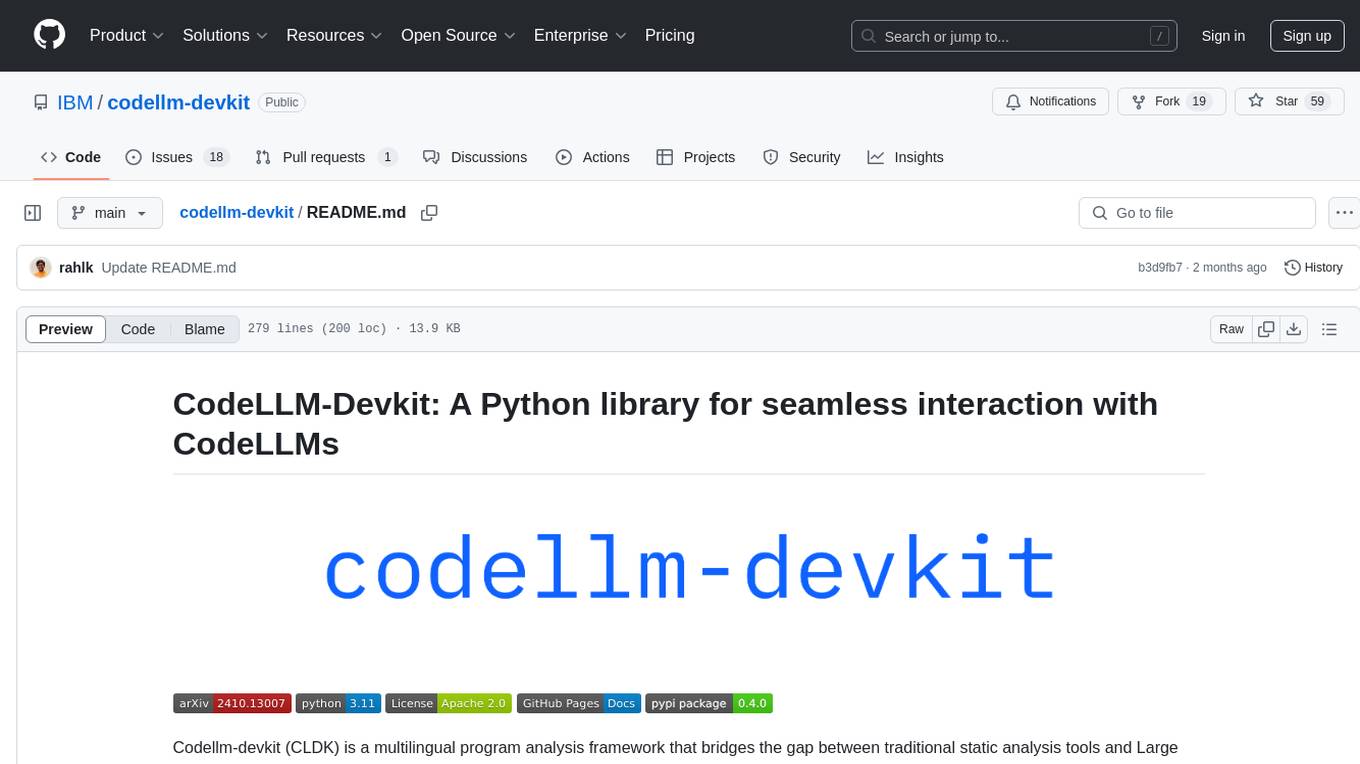
codellm-devkit
Codellm-devkit (CLDK) is a Python library that serves as a multilingual program analysis framework bridging traditional static analysis tools and Large Language Models (LLMs) specialized for code (CodeLLMs). It simplifies the process of analyzing codebases across multiple programming languages, enabling the extraction of meaningful insights and facilitating LLM-based code analysis. The library provides a unified interface for integrating outputs from various analysis tools and preparing them for effective use by CodeLLMs. Codellm-devkit aims to enable the development and experimentation of robust analysis pipelines that combine traditional program analysis tools and CodeLLMs, reducing friction in multi-language code analysis and ensuring compatibility across different tools and LLM platforms. It is designed to seamlessly integrate with popular analysis tools like WALA, Tree-sitter, LLVM, and CodeQL, acting as a crucial intermediary layer for efficient communication between these tools and CodeLLMs. The project is continuously evolving to include new tools and frameworks, maintaining its versatility for code analysis and LLM integration.
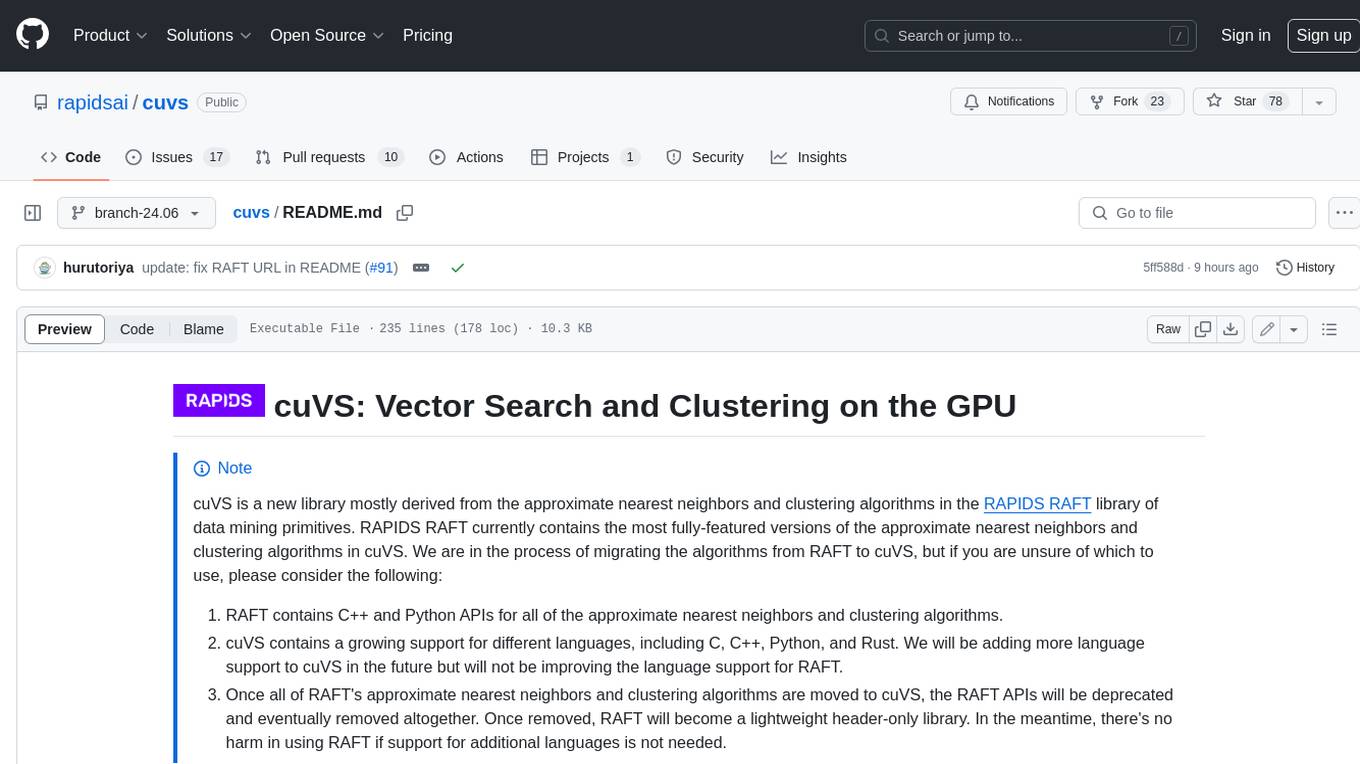
cuvs
cuVS is a library that contains state-of-the-art implementations of several algorithms for running approximate nearest neighbors and clustering on the GPU. It can be used directly or through the various databases and other libraries that have integrated it. The primary goal of cuVS is to simplify the use of GPUs for vector similarity search and clustering.
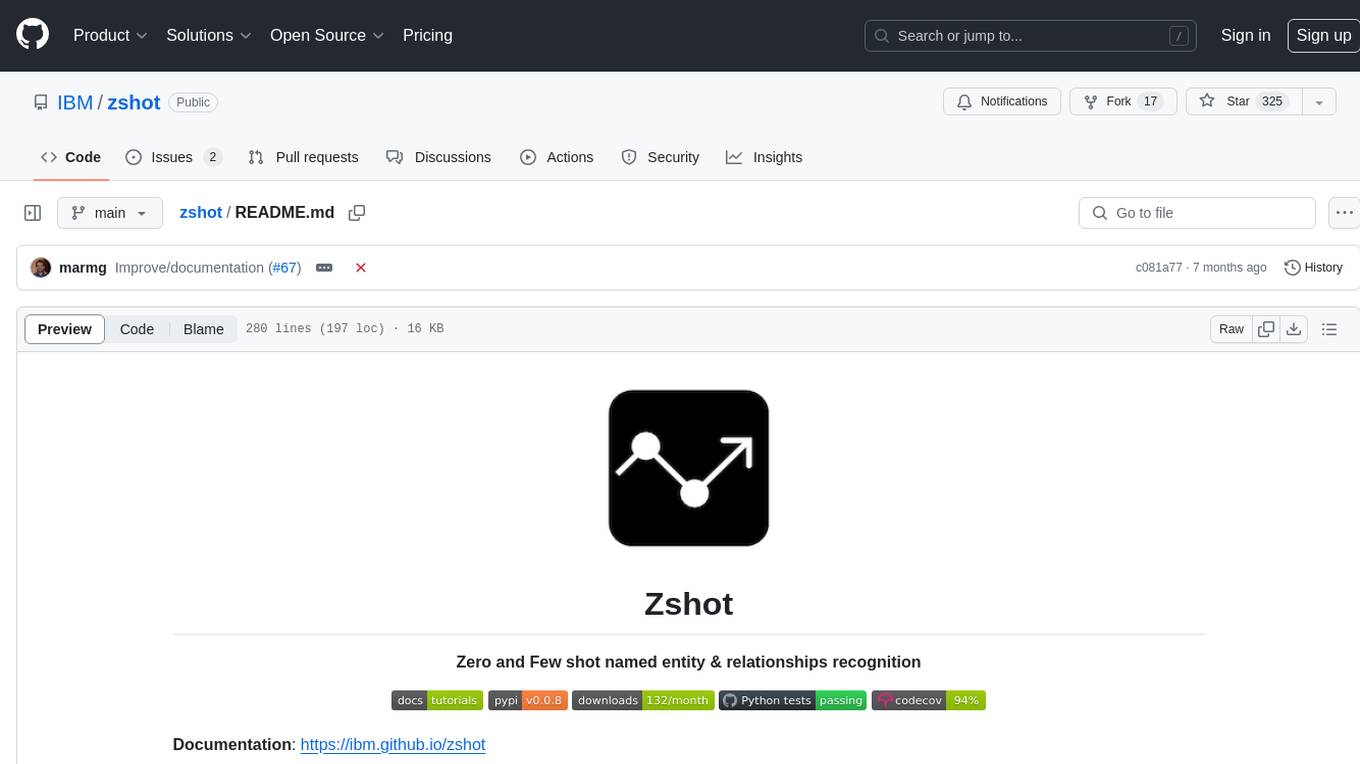
zshot
Zshot is a highly customizable framework for performing Zero and Few shot named entity and relationships recognition. It can be used for mentions extraction, wikification, zero and few shot named entity recognition, zero and few shot named relationship recognition, and visualization of zero-shot NER and RE extraction. The framework consists of two main components: the mentions extractor and the linker. There are multiple mentions extractors and linkers available, each serving a specific purpose. Zshot also includes a relations extractor and a knowledge extractor for extracting relations among entities and performing entity classification. The tool requires Python 3.6+ and dependencies like spacy, torch, transformers, evaluate, and datasets for evaluation over datasets like OntoNotes. Optional dependencies include flair and blink for additional functionalities. Zshot provides examples, tutorials, and evaluation methods to assess the performance of the components.
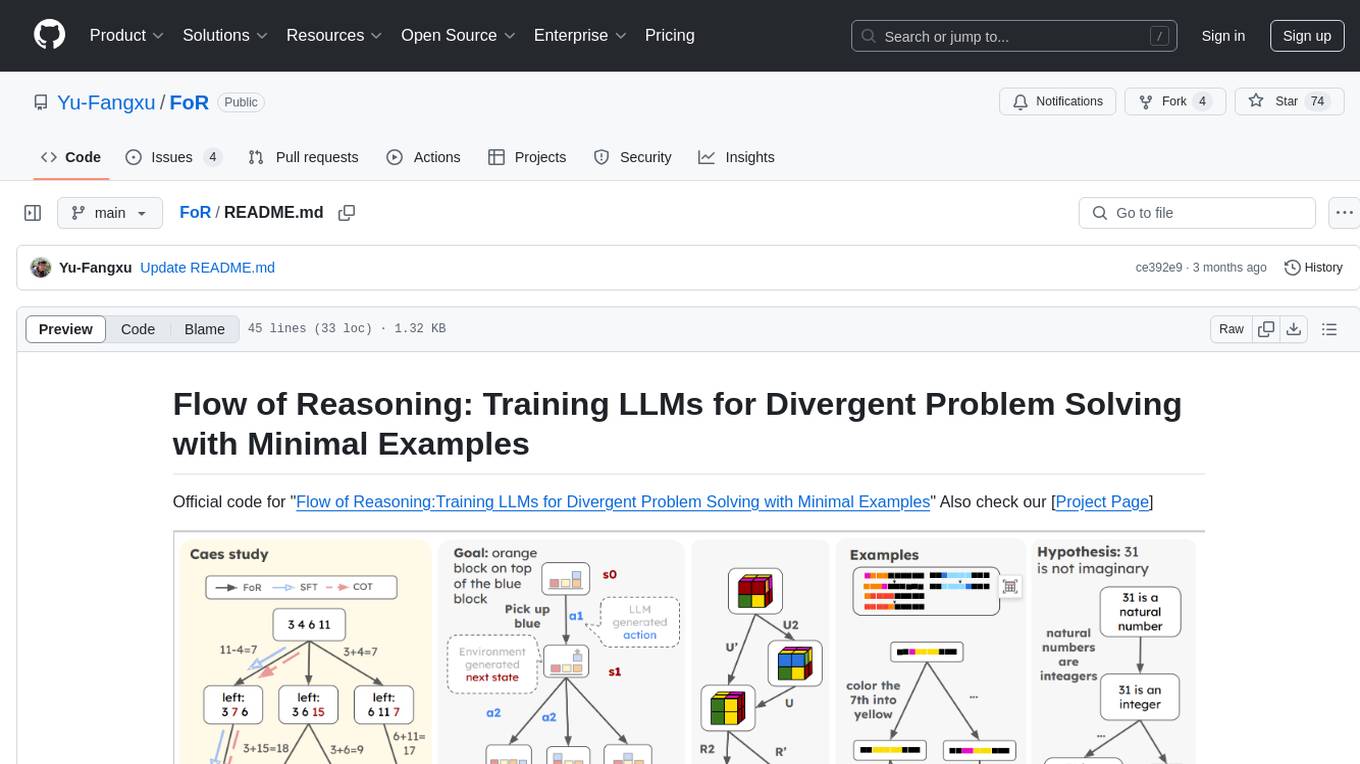
FoR
FoR is the official code repository for the 'Flow of Reasoning: Training LLMs for Divergent Problem Solving with Minimal Examples' project. It formulates multi-step reasoning tasks as a flow, involving designing reward functions, collecting trajectories, and training LLM policies with trajectory balance loss. The code provides tools for training and inference in a reproducible experiment environment using conda. Users can choose from 5 tasks to run, each with detailed instructions in the respective branches.
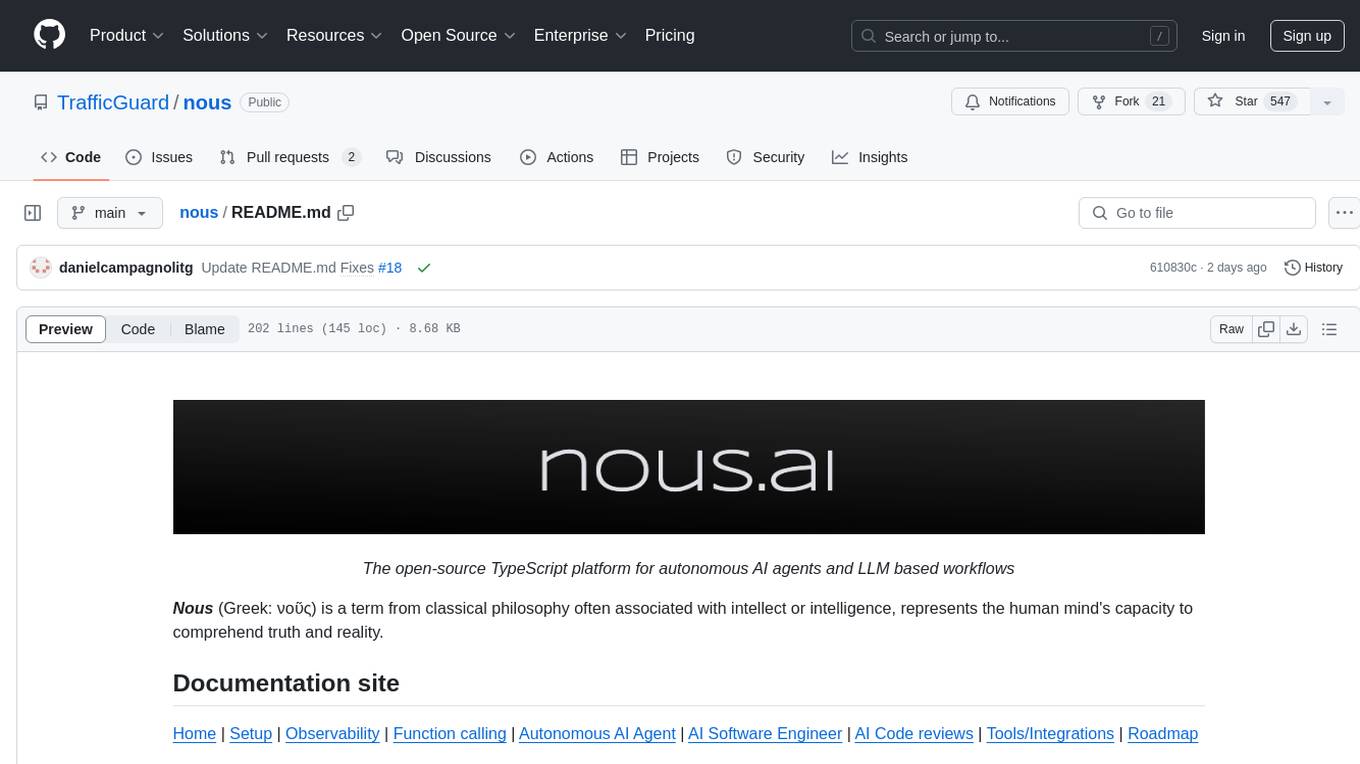
nous
Nous is an open-source TypeScript platform for autonomous AI agents and LLM based workflows. It aims to automate processes, support requests, review code, assist with refactorings, and more. The platform supports various integrations, multiple LLMs/services, CLI and web interface, human-in-the-loop interactions, flexible deployment options, observability with OpenTelemetry tracing, and specific agents for code editing, software engineering, and code review. It offers advanced features like reasoning/planning, memory and function call history, hierarchical task decomposition, and control-loop function calling options. Nous is designed to be a flexible platform for the TypeScript community to expand and support different use cases and integrations.
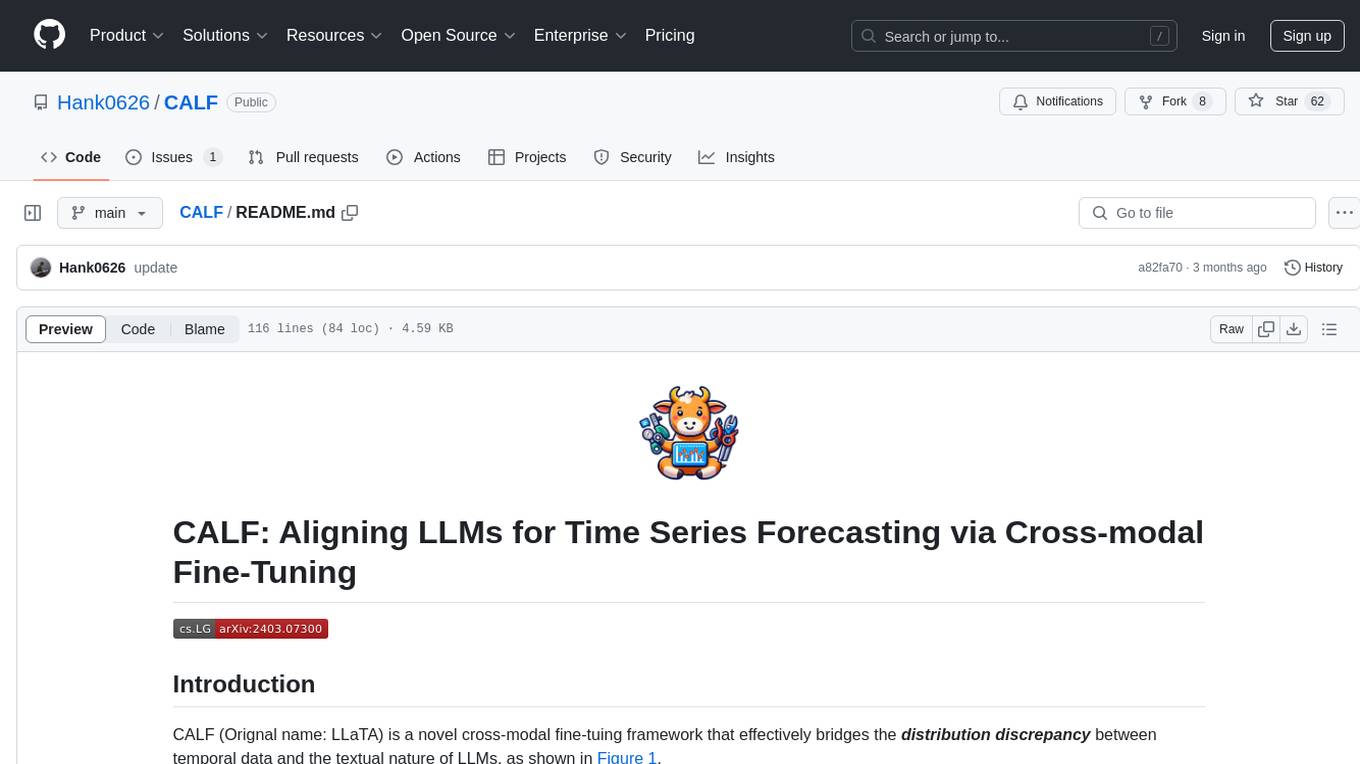
CALF
CALF (LLaTA) is a cross-modal fine-tuning framework that bridges the distribution discrepancy between temporal data and the textual nature of LLMs. It introduces three cross-modal fine-tuning techniques: Cross-Modal Match Module, Feature Regularization Loss, and Output Consistency Loss. The framework aligns time series and textual inputs, ensures effective weight updates, and maintains consistent semantic context for time series data. CALF provides scripts for long-term and short-term forecasting, requires Python 3.9, and utilizes word token embeddings for model training.
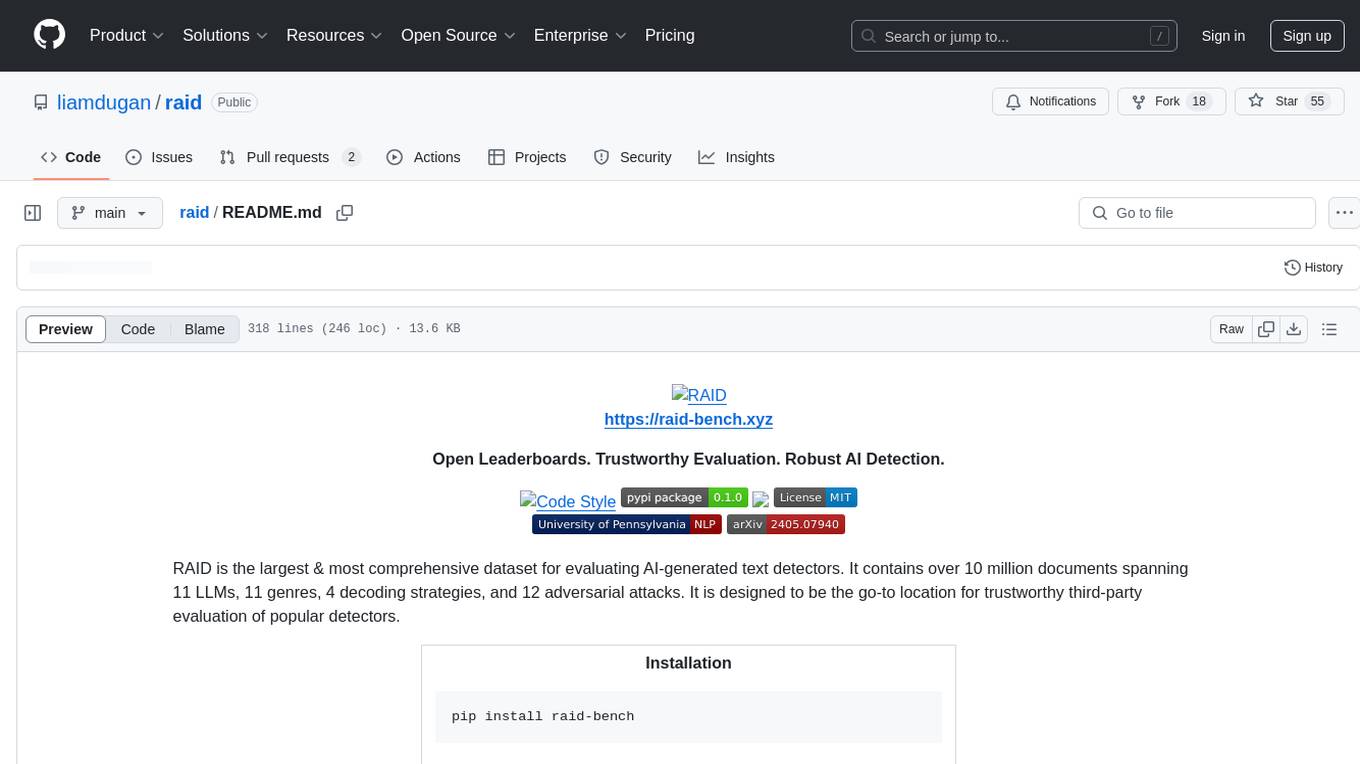
raid
RAID is the largest and most comprehensive dataset for evaluating AI-generated text detectors. It contains over 10 million documents spanning 11 LLMs, 11 genres, 4 decoding strategies, and 12 adversarial attacks. RAID is designed to be the go-to location for trustworthy third-party evaluation of popular detectors. The dataset covers diverse models, domains, sampling strategies, and attacks, making it a valuable resource for training detectors, evaluating generalization, protecting against adversaries, and comparing to state-of-the-art models from academia and industry.

universal
The Universal Numbers Library is a header-only C++ template library designed for universal number arithmetic, offering alternatives to native integer and floating-point for mixed-precision algorithm development and optimization. It tailors arithmetic types to the application's precision and dynamic range, enabling improved application performance and energy efficiency. The library provides fast implementations of special IEEE-754 formats like quarter precision, half-precision, and quad precision, as well as vendor-specific extensions. It supports static and elastic integers, decimals, fixed-points, rationals, linear floats, tapered floats, logarithmic, interval, and adaptive-precision integers, rationals, and floats. The library is suitable for AI, DSP, HPC, and HFT algorithms.
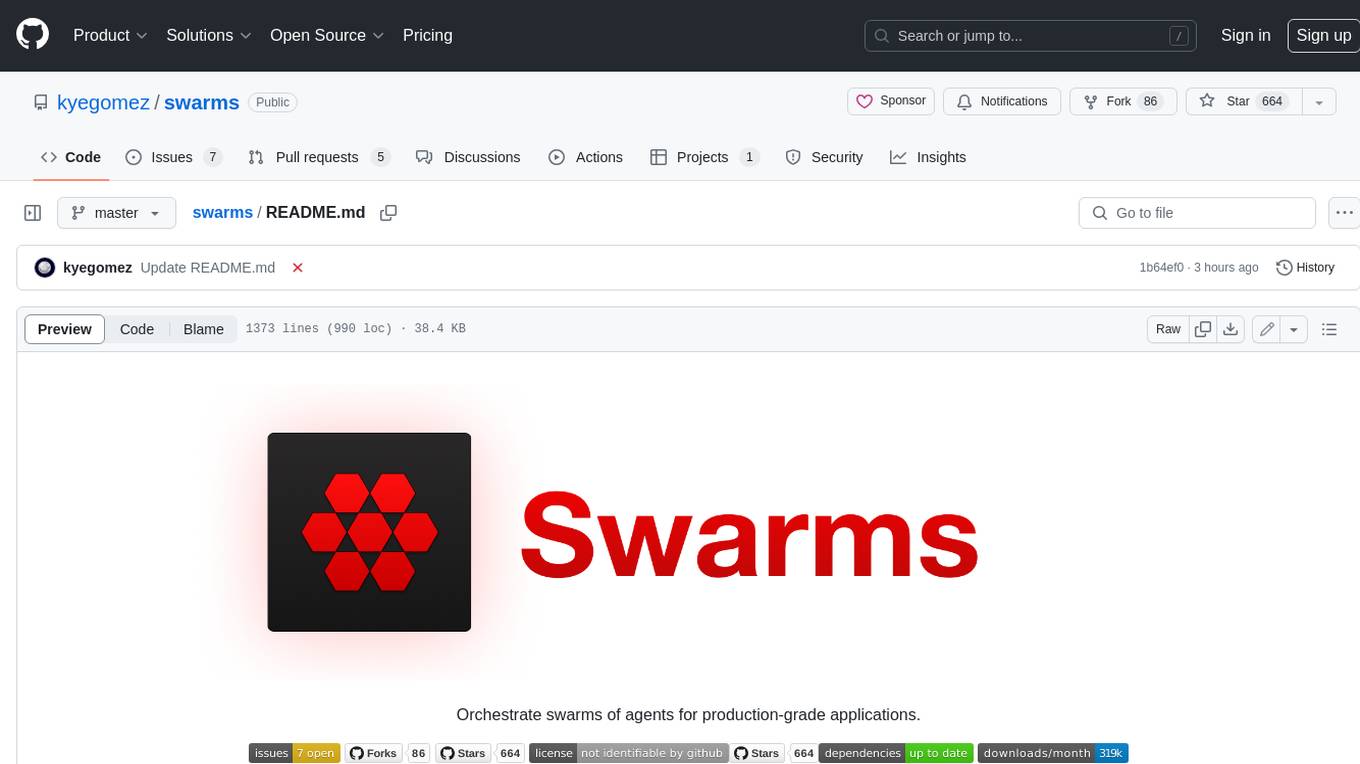
swarms
Swarms provides simple, reliable, and agile tools to create your own Swarm tailored to your specific needs. Currently, Swarms is being used in production by RBC, John Deere, and many AI startups.
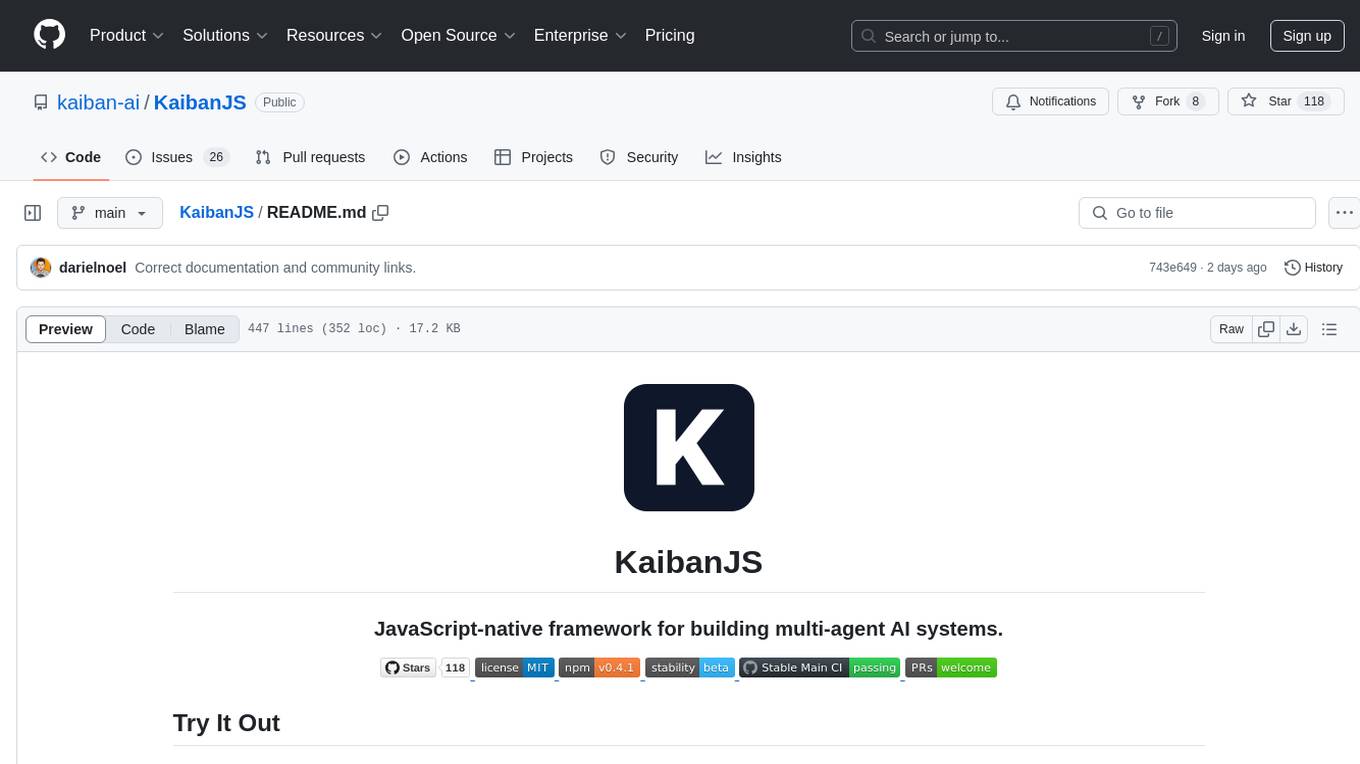
KaibanJS
KaibanJS is a JavaScript-native framework for building multi-agent AI systems. It enables users to create specialized AI agents with distinct roles and goals, manage tasks, and coordinate teams efficiently. The framework supports role-based agent design, tool integration, multiple LLMs support, robust state management, observability and monitoring features, and a real-time agentic Kanban board for visualizing AI workflows. KaibanJS aims to empower JavaScript developers with a user-friendly AI framework tailored for the JavaScript ecosystem, bridging the gap in the AI race for non-Python developers.
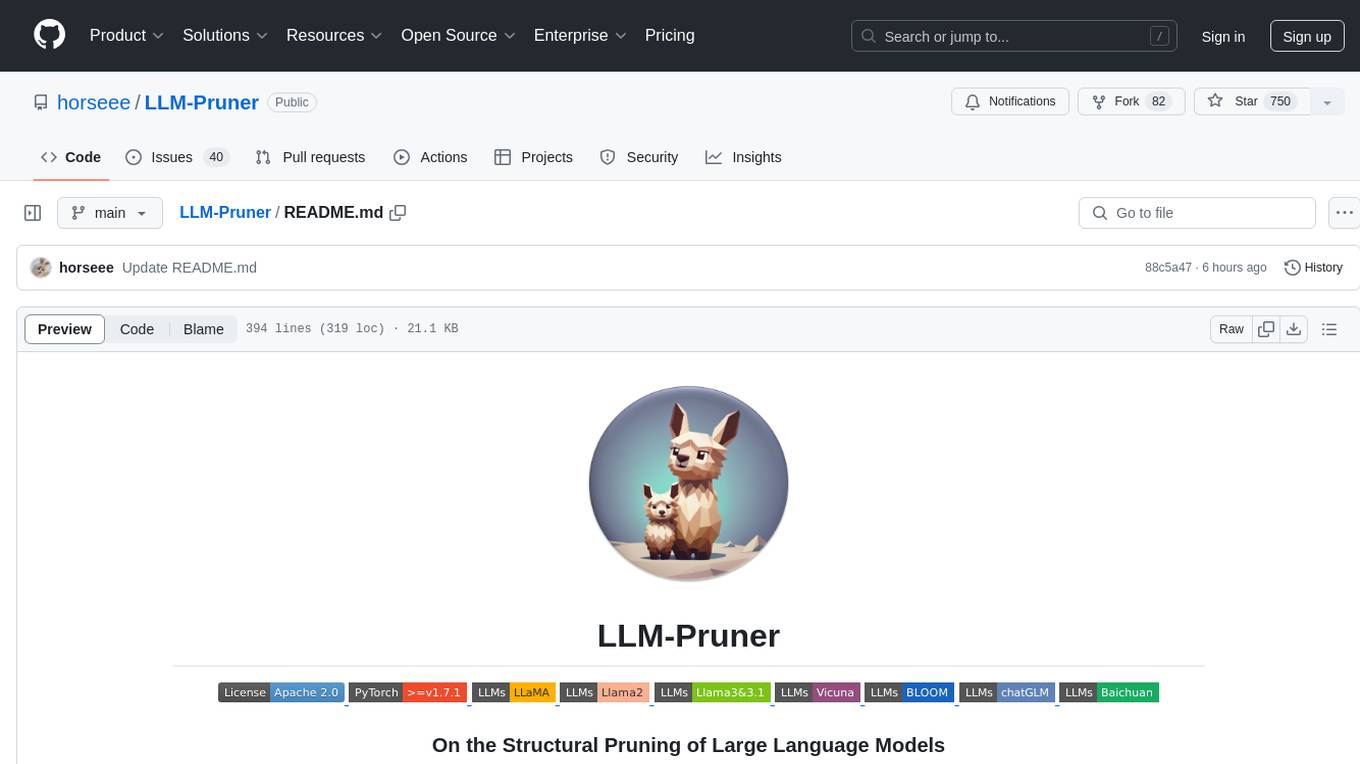
LLM-Pruner
LLM-Pruner is a tool for structural pruning of large language models, allowing task-agnostic compression while retaining multi-task solving ability. It supports automatic structural pruning of various LLMs with minimal human effort. The tool is efficient, requiring only 3 minutes for pruning and 3 hours for post-training. Supported LLMs include Llama-3.1, Llama-3, Llama-2, LLaMA, BLOOM, Vicuna, and Baichuan. Updates include support for new LLMs like GQA and BLOOM, as well as fine-tuning results achieving high accuracy. The tool provides step-by-step instructions for pruning, post-training, and evaluation, along with a Gradio interface for text generation. Limitations include issues with generating repetitive or nonsensical tokens in compressed models and manual operations for certain models.
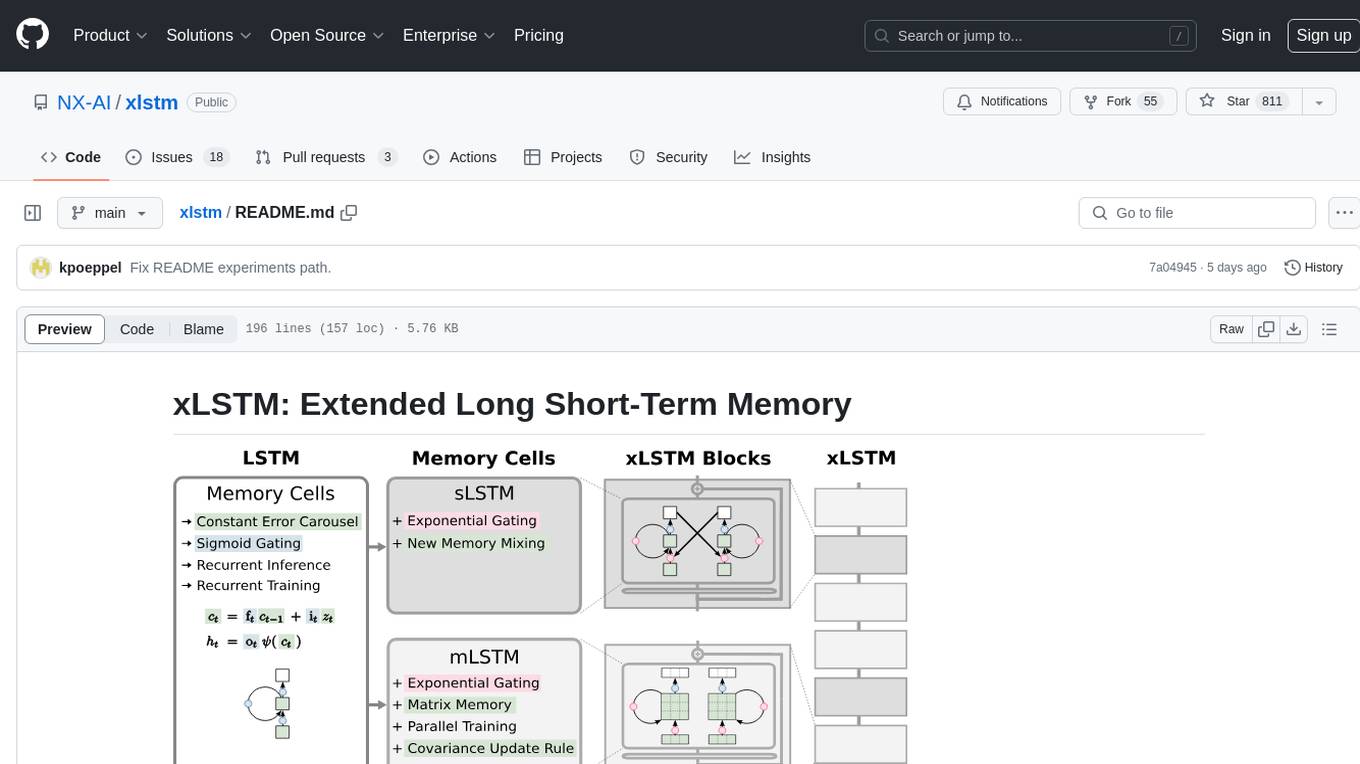
xlstm
xLSTM is a new Recurrent Neural Network architecture based on ideas of the original LSTM. Through Exponential Gating with appropriate normalization and stabilization techniques and a new Matrix Memory it overcomes the limitations of the original LSTM and shows promising performance on Language Modeling when compared to Transformers or State Space Models. The package is based on PyTorch and was tested for versions >=1.8. For the CUDA version of xLSTM, you need Compute Capability >= 8.0. The xLSTM tool provides two main components: xLSTMBlockStack for non-language applications or integrating in other architectures, and xLSTMLMModel for language modeling or other token-based applications.
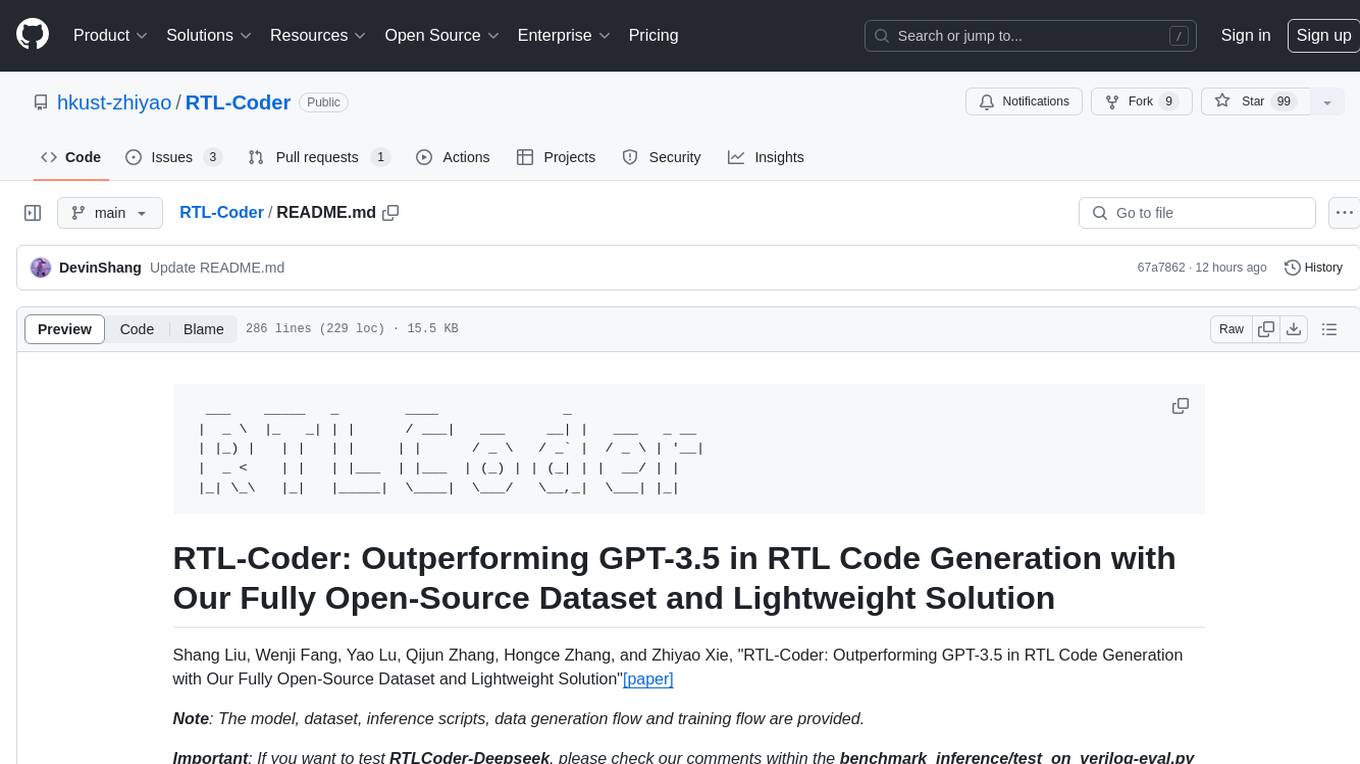
RTL-Coder
RTL-Coder is a tool designed to outperform GPT-3.5 in RTL code generation by providing a fully open-source dataset and a lightweight solution. It targets Verilog code generation and offers an automated flow to generate a large labeled dataset with over 27,000 diverse Verilog design problems and answers. The tool addresses the data availability challenge in IC design-related tasks and can be used for various applications beyond LLMs. The tool includes four RTL code generation models available on the HuggingFace platform, each with specific features and performance characteristics. Additionally, RTL-Coder introduces a new LLM training scheme based on code quality feedback to further enhance model performance and reduce GPU memory consumption.

AutoMathText
AutoMathText is an extensive dataset of around 200 GB of mathematical texts autonomously selected by the language model Qwen-72B. It aims to facilitate research in mathematics and artificial intelligence, serve as an educational tool for learning complex mathematical concepts, and provide a foundation for developing AI models specialized in processing mathematical content.
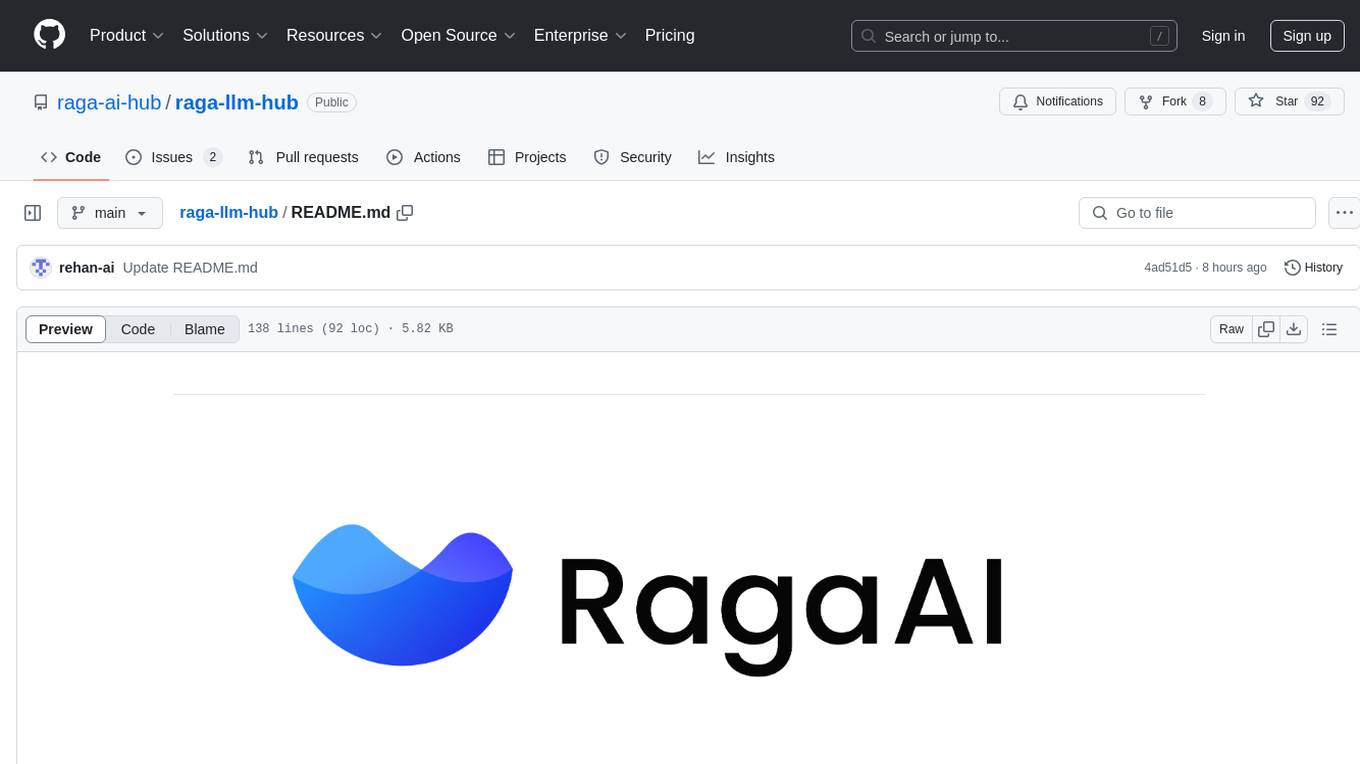
raga-llm-hub
Raga LLM Hub is a comprehensive evaluation toolkit for Language and Learning Models (LLMs) with over 100 meticulously designed metrics. It allows developers and organizations to evaluate and compare LLMs effectively, establishing guardrails for LLMs and Retrieval Augmented Generation (RAG) applications. The platform assesses aspects like Relevance & Understanding, Content Quality, Hallucination, Safety & Bias, Context Relevance, Guardrails, and Vulnerability scanning, along with Metric-Based Tests for quantitative analysis. It helps teams identify and fix issues throughout the LLM lifecycle, revolutionizing reliability and trustworthiness.
For similar tasks

GOLEM
GOLEM is an open-source AI framework focused on optimization and learning of structured graph-based models using meta-heuristic methods. It emphasizes the potential of meta-heuristics in complex problem spaces where gradient-based methods are not suitable, and the importance of structured models in various problem domains. The framework offers features like structured model optimization, metaheuristic methods, multi-objective optimization, constrained optimization, extensibility, interpretability, and reproducibility. It can be applied to optimization problems represented as directed graphs with defined fitness functions. GOLEM has applications in areas like AutoML, Bayesian network structure search, differential equation discovery, geometric design, and neural architecture search. The project structure includes packages for core functionalities, adapters, graph representation, optimizers, genetic algorithms, utilities, serialization, visualization, examples, and testing. Contributions are welcome, and the project is supported by ITMO University's Research Center Strong Artificial Intelligence in Industry.
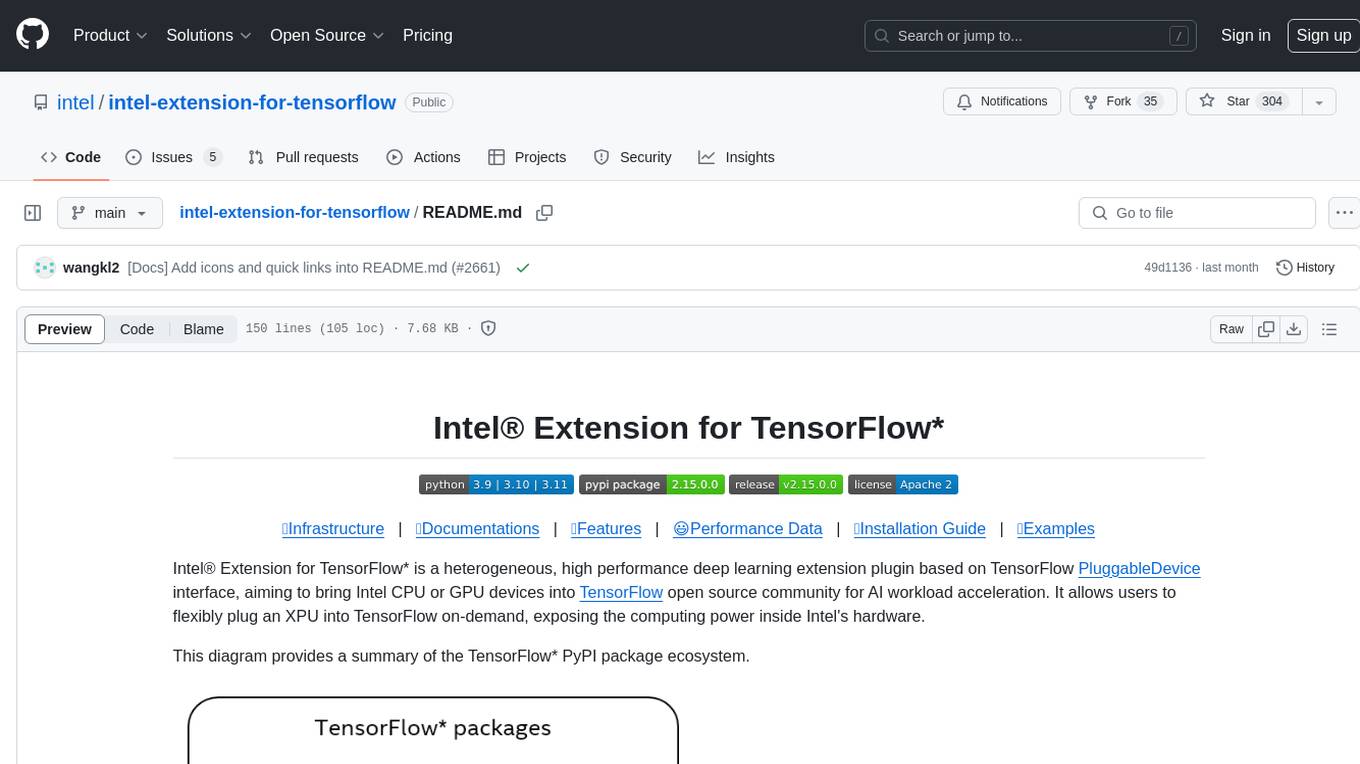
intel-extension-for-tensorflow
Intel® Extension for TensorFlow* is a high performance deep learning extension plugin based on TensorFlow PluggableDevice interface. It aims to accelerate AI workloads by allowing users to plug Intel CPU or GPU devices into TensorFlow on-demand, exposing the computing power inside Intel's hardware. The extension provides XPU specific implementation, kernels & operators, graph optimizer, device runtime, XPU configuration management, XPU backend selection, and options for turning on/off advanced features.
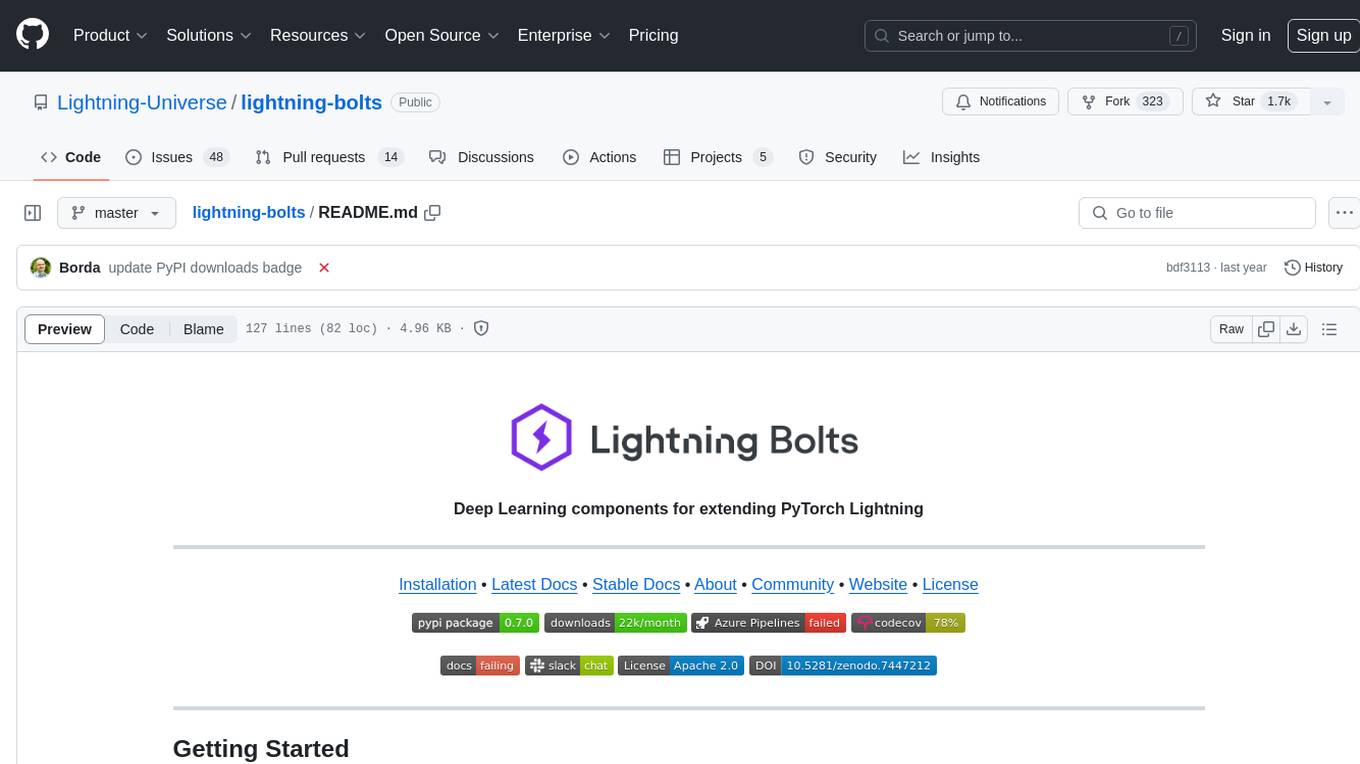
lightning-bolts
Bolts package provides a variety of components to extend PyTorch Lightning, such as callbacks & datasets, for applied research and production. Users can accelerate Lightning training with the Torch ORT Callback to optimize ONNX graph for faster training & inference. Additionally, users can introduce sparsity with the SparseMLCallback to accelerate inference by leveraging the DeepSparse engine. Specific research implementations are encouraged, with contributions that help train SSL models and integrate with Lightning Flash for state-of-the-art models in applied research.
For similar jobs

sweep
Sweep is an AI junior developer that turns bugs and feature requests into code changes. It automatically handles developer experience improvements like adding type hints and improving test coverage.

teams-ai
The Teams AI Library is a software development kit (SDK) that helps developers create bots that can interact with Teams and Microsoft 365 applications. It is built on top of the Bot Framework SDK and simplifies the process of developing bots that interact with Teams' artificial intelligence capabilities. The SDK is available for JavaScript/TypeScript, .NET, and Python.

ai-guide
This guide is dedicated to Large Language Models (LLMs) that you can run on your home computer. It assumes your PC is a lower-end, non-gaming setup.

classifai
Supercharge WordPress Content Workflows and Engagement with Artificial Intelligence. Tap into leading cloud-based services like OpenAI, Microsoft Azure AI, Google Gemini and IBM Watson to augment your WordPress-powered websites. Publish content faster while improving SEO performance and increasing audience engagement. ClassifAI integrates Artificial Intelligence and Machine Learning technologies to lighten your workload and eliminate tedious tasks, giving you more time to create original content that matters.

chatbot-ui
Chatbot UI is an open-source AI chat app that allows users to create and deploy their own AI chatbots. It is easy to use and can be customized to fit any need. Chatbot UI is perfect for businesses, developers, and anyone who wants to create a chatbot.

BricksLLM
BricksLLM is a cloud native AI gateway written in Go. Currently, it provides native support for OpenAI, Anthropic, Azure OpenAI and vLLM. BricksLLM aims to provide enterprise level infrastructure that can power any LLM production use cases. Here are some use cases for BricksLLM: * Set LLM usage limits for users on different pricing tiers * Track LLM usage on a per user and per organization basis * Block or redact requests containing PIIs * Improve LLM reliability with failovers, retries and caching * Distribute API keys with rate limits and cost limits for internal development/production use cases * Distribute API keys with rate limits and cost limits for students

uAgents
uAgents is a Python library developed by Fetch.ai that allows for the creation of autonomous AI agents. These agents can perform various tasks on a schedule or take action on various events. uAgents are easy to create and manage, and they are connected to a fast-growing network of other uAgents. They are also secure, with cryptographically secured messages and wallets.

griptape
Griptape is a modular Python framework for building AI-powered applications that securely connect to your enterprise data and APIs. It offers developers the ability to maintain control and flexibility at every step. Griptape's core components include Structures (Agents, Pipelines, and Workflows), Tasks, Tools, Memory (Conversation Memory, Task Memory, and Meta Memory), Drivers (Prompt and Embedding Drivers, Vector Store Drivers, Image Generation Drivers, Image Query Drivers, SQL Drivers, Web Scraper Drivers, and Conversation Memory Drivers), Engines (Query Engines, Extraction Engines, Summary Engines, Image Generation Engines, and Image Query Engines), and additional components (Rulesets, Loaders, Artifacts, Chunkers, and Tokenizers). Griptape enables developers to create AI-powered applications with ease and efficiency.